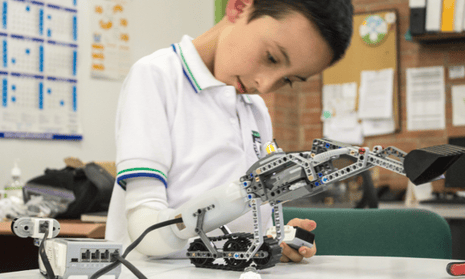Children could soon see their favourite toy grafted on to the end of their arm, thanks to designs for Lego prosthetics that allow everything from mechanical diggers to laser-firing spaceships to be screwed on to the end of a child’s limb.
Iko is the work of the Chicago-based Colombian designer, Carlos Arturo Torres, and is a modular system that allows children to customise their own prosthetics with the ease of clicking together plastic bricks. The only limit is their imagination – and what they can find at the bottom of the Lego box.

Designed with Lego’s Future Lab, the Danish toy company’s experimental research department, and Cirec, a Colombian foundation for physical rehabilitation, the modular prosthetic incorporates myoelectric sensors that register the activity of the muscle in the stump and send a signal to control movement in the attachment. A processing unit in the body of the prosthetic contains an engine compatible with Lego Mindstorms, the company’s robotics line, which lets the wearer build an extensive range of customised, programmable limbs.
“There had to be a right balance between a playful experience and something functional,” says Torres, who recently won a Core 77 design award for the project. “Something that could allow kids to explore their creativity, something they could be proud of. Sometimes a functional element is everything they need – but at other times it might be a spaceship, a doll’s house, a telescope, a video game controller or a swim fin.”
“There were many problems I was trying to understand,” he adds. “The negative perception that kids have of prosthetics; the focus that companies put on engineering and not on the human part of a child; the social isolation felt by kids because of their condition and how hard it can be for them to build strong self-esteem. My idea was not to make a traditional prosthetic, but to propose a system that was flexible enough for kids to use, hack and create by themselves and with their friends.”
For Torres, Lego is only the beginning of a future of toy-based body parts. He says the nature of the system would potentially allow it to be compatible with other products.
“Imagine Marvel developing superhero modules,” he says. “Or Mattel making dolls’ houses or car launchers, GE producing microscopes and Nintendo having compatible accessories.”
It suggests a thrilling world of cool augmented limbs in the playgrounds of tomorrow.

Comments (…)
Sign in or create your Guardian account to join the discussion